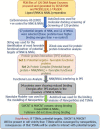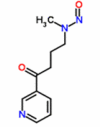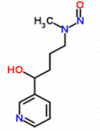Tobacco Smoke Carcinogens Induce DNA Repair Machinery Function Loss: Protection by Carbon Nanotubes
- PMID: 33112573
- PMCID: PMC7798159
- DOI: 10.31557/APJCP.2020.21.10.3099
Tobacco Smoke Carcinogens Induce DNA Repair Machinery Function Loss: Protection by Carbon Nanotubes
Abstract
Purpose: DNA damage is a continuous process occurring within the cells caused by intrinsic and extrinsic factors, but it gets repaired regularly. If the DNA repair process is faulty, the incidences of damages/mutations can accumulate in cells resulting in cell transformation. It is hypothesized that the negative variations in DNA repair pathways in even at one point viz. genetic, translational or posttranslational stage may fairly be crucial for the beginning and development of carcinogenesis. Therefore, we investigated the potential of tobacco specific nitrosamines (TSNs) related carcinogens to interact with the enzymes involved in DNA repair mechanisms in the current study.
Methods: The derivatives of cigarettes' smoke like NNK and NNAL are very well known and recognized carcinogens. Therefore, almost 120 enzymes playing crucial role in the DNA repair process have been analysed for their reactivity with NNK and NNAL.
Results: The molecular docking study helped to screen out, 07 possible DNA repair enzyme targets for NNK, and 12for NNAL. Present study revealed the loss of activity of DNA repair enzymes in the presence of NNK and NNAL, and this accumulation may induce the tendency of DNA damage which can lead the transformation of exposed normal cells in to cancerous cells. This study also demonstrated the protective potential of nanoparticles like SWCNTs/MWCNTs against TSN's induced toxicity; here SWCNT against NNK (-17.16 Kcal/Mol) and MWCNT against NNK -17.01 Kcal/Mol were showing maximum binding affinities than the known biomolecular target of NNK 1UGH (Uracil-DNA glycosylase,-7.82Kcal/Mol).
Conclusion: CNTs can be applied as chemo-preventive agents against environmental and tobacco induced carcinogens owing to their scavenging potential and warrants for in vivo and in vitro experimental validation of the results obtained from the present study.<br />.
Keywords: DNA damage; Molecular docking; NNAL; NNK; cancer.
Figures








Similar articles
-
Binding Pattern Elucidation of NNK and NNAL Cigarette Smoke Carcinogens with NER Pathway Enzymes: an Onco- Informatics Study.Asian Pac J Cancer Prev. 2015;16(13):5311-7. doi: 10.7314/apjcp.2015.16.13.5311. Asian Pac J Cancer Prev. 2015. PMID: 26225671
-
Molecular interaction analysis of cigarette smoke carcinogens NNK and NNAL with enzymes involved in DNA repair pathways: An in silico approach.Bioinformation. 2012;8(17):795-800. doi: 10.6026/97320630008795. Epub 2012 Sep 11. Bioinformation. 2012. PMID: 23139587 Free PMC article.
-
Aldehydes are the predominant forces inducing DNA damage and inhibiting DNA repair in tobacco smoke carcinogenesis.Proc Natl Acad Sci U S A. 2018 Jul 3;115(27):E6152-E6161. doi: 10.1073/pnas.1804869115. Epub 2018 Jun 18. Proc Natl Acad Sci U S A. 2018. PMID: 29915082 Free PMC article.
-
DNA damage, DNA repair and carcinogenicity: Tobacco smoke versus electronic cigarette aerosol.Mutat Res Rev Mutat Res. 2022 Jan-Jun;789:108409. doi: 10.1016/j.mrrev.2021.108409. Epub 2021 Dec 20. Mutat Res Rev Mutat Res. 2022. PMID: 35690412 Free PMC article. Review.
-
DNA adduct formation from tobacco-specific N-nitrosamines.Mutat Res. 1999 Mar 8;424(1-2):127-42. doi: 10.1016/s0027-5107(99)00014-7. Mutat Res. 1999. PMID: 10064856 Review.
Cited by
-
Sustainable green approach to synthesize Fe3O4/α-Fe2O3 nanocomposite using waste pulp of Syzygium cumini and its application in functional stability of microbial cellulases.Sci Rep. 2021 Dec 21;11(1):24371. doi: 10.1038/s41598-021-03776-w. Sci Rep. 2021. PMID: 34934128 Free PMC article.
References
-
- Agnihotri S, Jose´ PBM, Rostam-Abadi M, Mark J. Rood structural characterization of single-walled carbon nanotube bundles by experiment and molecular simulation. Langmuir. 2005;21:896–904. - PubMed
-
- Alberto C, Angelos C, Stephen CW. 2003) Identification and characterization of the human Mus81-Eme1 endonuclease. J Biol Chem. 278:25172–8. - PubMed
-
- Chen R, Li L, Weng Z. ZDOCK: an initial-stage protein-docking algorithm. Proteins. 2003;52:80. - PubMed
-
- Dhasmana A, Jamal QMS, Gupta R, et al. Titanium dioxide nanoparticles provide protection against polycyclic aromatic hydrocarbon BaP& chrysene induced perturbation of DNA repair machinery: A Computational Biology Approach. Biotechnol Appl Biochem. 2015;63:497–513. - PubMed
MeSH terms
Substances
LinkOut - more resources
Full Text Sources
Medical
Research Materials

